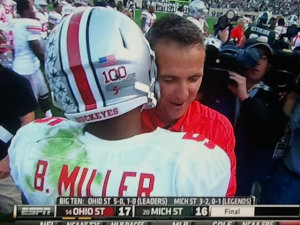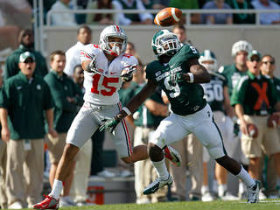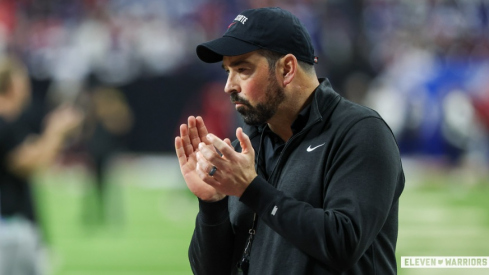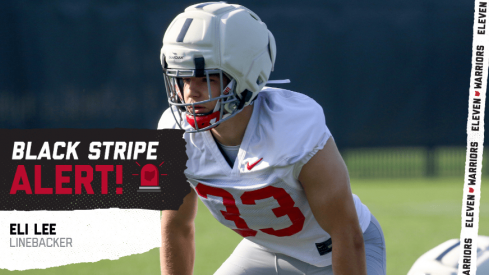It wasn't always pretty, but the offense and defense roughly continued their level of play from the non-conference part of the schedule:
Braxton continued to be the offensive spark (the team clearly will live and die on his back this year), middle linebacker play was weak, and the defense gave up a lot of passing yards due to short passes.
But the Buckeyes won - don't forget it!
 Braxton had a few mistakes, but is tough as nails
Braxton had a few mistakes, but is tough as nailsOffense
The Buckeyes' offensive performance can be understood best through the quickstrike metric, which was a much lower .313 points per play compared to the non-conference average of .54.
Put another way, a ten-play drive would average just a field goal, in comparison to almost a touchdown during the non-conference schedule. While the overall offensive performance was just slightly under its non-conference total yard average, the quick strike score is much lower.
We can explain the Buckeyes' performance by comparing the quick strike score (much lower than the Buckeyes' average) with their total yards (roughly equal to their average). The roughly equal total yardage but lower point total likely corroborates the opinion you formed while watching the game in the bar: turnovers and not finishing drives killed the Buckeyes' offense.
| 1D | 3D% | 4D% | Yards | Passing | Rushing | TO | Penalties | QuickStrike | Sacks | |
|---|---|---|---|---|---|---|---|---|---|---|
| vs.MSU | 21(107) | 46% | - | 383(418, 2091) | 179(194, 970) | 204(224, 1121) | 3 (7) | 6-65 (7-65) | .313 | 1(1.6,8) |
| Non-Con | 86 | - | - | (427, 1708) | (198, 791) | (229,917) | 4 | 31-260 | .54 | 7 |
If the Buckeyes had ended up losing this game then we'd all be putting blame on Braxton's three turnovers (almost doubling the total number of turnovers coming into the game) and the untimely penalties (Roby's holding was on an incomplete pass on third and six, while the facemask was on second and long right before the crazy Keith Mumphery touchdown pass).
It's true that the Spartan defense was the best the Buckeyes have played by far, coming into the game as the 12th-ranked scoring defense, but I believe that that alone does not fully account for the offensive performance because the rushing and passing yardage were similar to non-conference games.
Also, the penalties section here is actually a little misleading, as most of the penalties were on defense, including two costly Roby errors - an untimely facemask and a defensive holding call.
The offense had a number of three-and-outs against UAB and Cal, while only coming up with three three-and-outs and four overall punts against the stout Michigan State defense. It's clear that the Buckeyes left a lot of potential points on the field due to turnovers.
Finally, a little shoutout to the offensive line, which only game up a single sack against Michigan State when they gave up nine last year. Jerel Worthy, who is now in the NFL, wasn't 8 sacks kind of good. So, good work guys.
The Clock. The Buckeyes showed the ability to control the clock even with the no-huddle offense:
| Time of Possession | # of Plays | |
|---|---|---|
| vs. MSU | 30:27 | 67 |
| Season | 29:12 | 347 (69.4) |
| Last Season | 30:40 | 62 |
The Buckeyes were able to eat up the final four minutes and ten seconds of game time, running out the clock by picking up two crucial first downs. This is even more impressive because Michigan State knew what was coming, but was unable to stop it. Hyde deserves an individual shoutout here, as Meyer told him to "go win this game for us" before Hyde gutted out 18 yards on three carries to seal the deal.
The Buckeyes continue to average almost 8 more plays per game than they did last year, though this number is probably a little less than Meyer and Herman (especially) would like. I'd imagine they shoot for somewhere north of 70, which is what the offense would have had if not for the three turnovers.
The game against the Spartans is third in which the Buckeyes were able to "win the time of possession battle" (which is often a pyrrhic victory IMO). In fact, the only reason the season average is less than thirty is because of an outlier game against Cal, where the Buckeye offense didn't even have the ball for 25 minutes.
The Defense
The defense finally looked like the defense we've expected, limiting the Spartans to 34 total rushing yards, even though Maxwell was just 6 yards shy of his season high in pass yards.
| Opp 1d | Opp Yards | Opp Pass | Opp Rush | TO | Opp TOP | TFL | Sacks | INT | 3 & Outs | Opp RBSR | Quicksand | |
|---|---|---|---|---|---|---|---|---|---|---|---|---|
| vs.MSU | 17(89) | 303(1882) | 269(1378) | 34(504) | - (9) | 29:33 | 4 (20) | 2 (12) | (7) | 2(12) | 27% | .266 |
| Non-Con | 72 | 395(1579) | 277(1109) | 118(470) | 9 | 31:06 | 16 | 10 | 7 | 10 | 44%(UAB) | .24 |
The chart above includes season totals in parentheses (in the "vs. MSU" column) and then non-conference average and total numbers. I'll continue to separate conference and non-conference numbers.
The Buckeye defense held the Michigan State offense under our non-conference averages for pass and rush yards. That's right - UAB, Cal, UCF, and Miami all performed "better" than Michigan State against our defense.
 Understatement: this was an important play.
Understatement: this was an important play. Two observations here: 1. The Quicksand score is actually a bit higher than the nonconference average, indicating that the Spartans were slightly more efficient than our non-conference foes. 2. This is likely related to what Meyer and Ross said earlier in the week - that the Buckeye defense is much better situated for pro-style offenses than spread ones.
The Buckeyes were able to have their best defensive performance of the season while still having a relatively worse quicksand score because of Maxwell's passing efficiency against the Buckeye secondary. Maxwell had to be efficient because of the terrible performance of the Spartan rushing game - only a 27% running back success rate for Bell, which was lower than UAB's rate.
The Spartan offense continued the trend of Buckeye opponents using a high number of quick, short passes and screens against the Buckeye secondary. While the Buckeye defense limited Maxwell to slightly worse numbers than they averaged over the non-conference schedule, Maxwell was just three attempts off his season high of 45.
The Spartan game plan was to pass early and often - 5 in a row on first possession and 7 in a row in the Spartans' last possession of the first half - mostly because Bell was unable to gain any real traction against the Buckeye defense (Bell's best carry was for 8 yards).
It will be interesting if the Buckeyes are able to tighten up the secondary and defend against the short passes and screens in the future, as we're likely to see more of this game plan throughout the year.
Player Analysis
Braxton Miller. Apart from a lazily-throw interception, Braxton continued to be efficient, if not dominant, through the air:
| Comp/ATT | % | Yards | TD | INT | Rating | |
|---|---|---|---|---|---|---|
| Miller | 16/23 (76/121) | 70% (63%) | 179(933) | 1(8) | 1(3) | 140.6 (145.3) |
Braxton is currently averaging 186 passing yards per game, so his turnout against the vaunted Spartan defense is laudable. While his interception (and later fumbles) killed a promising drive, Braxton was efficient apart from that throw, completing approximately 70% of his passes.
| Into Coverage | Uncatchable | Throw Away | Difficult | Catchable | Dead On | |
|---|---|---|---|---|---|---|
| Miller | 3 (9) | 1(10) | - (4) | 4(21) | 1(35) | 11 (40) |
Braxton continued his basic distribution of passes, throwing far more catchable and dead-on balls than not. He did, however, force a few throws into tighter coverage (and get one tipped at the line of scrimmage).
I believe that the offensive staff set Braxton up well by calling mostly high-percentage screens and short passes rather than more difficult intermediate and deep balls. Most of his "dead on" throws were of the screen-variety. However, if you can remember, Braxton actually struggled with these throws last year, often overthrowing his running backs and receivers on these short passes. It's small, but there's clear improvement.
I will say that Braxton's touchdown pass to Devin Smith was right on the money, as was his scramble away from pressure and sideline pass to Philly to convert a much-needed third down.
Rushing. Braxton continued to be the most prolific runner on the team, averaging ~6.5 yards a carry and leading the team with 142 yards after not including a sack attempt. The problem isn't Braxton, however - it's the actual running backs staying healthy.
| Att | Yards | YPC | RBSR | Ex Plays | YPC-Ex PLays | |
|---|---|---|---|---|---|---|
| Hyde | 11(35) | 49(158) | 4.5 (4.5) | 55%(54%) | (16) | 4.5 (4.18) |
| Miller | 22(90) | 142(596) | 6.45 | 59%(62%) | (17,33,22, 65,37,24,55,19,17,20) | 5.8 |
| Dunn | - (12) | - (60) | (5.0) | - (82%) | - | (5.0) |
| Boren | - (11) | - (33) | (3.0) | - (64%) | - | (3.0) |
| R. Smith | - (12) | - (50) | (4.17) | - (75%) | - | (4.17) |
| C. Brown | 1(5) | 6(48) | 6.0 (9.6) | 100%(100%) | (19) | 7.25 |
| Hall | 6(40) | 26(218) | 4.3 (5.45) | 83% (73%) | (15) | 4.3(5.2) |
The running game, which was just slightly worse against the Spartans than against the Buckeyes' non-conference foes, just can't seem to shake injuries.
It's really a shame that Hall is injured again, however, as he remains easily the most efficient regular running back with more than 30 attempts. In fact, his only inefficient attempt of the game was on an extremely poor read by Braxton that resulted in a loss of six yards.
I'd also like to commend him for his speech in the huddle near the end of the game - at the end of the commercial break we could see Hall go around to the offense and talk to each player individually, patting their shoulder pads and pointing to his heart. It's easy to see why he's a team captain.
Hyde performed well in his return from injury, though almost all of his successful rushes came near the end of the game. In particular, his blocks were incredible throughout the game. He was often tasked as one of the lead blockers for Braxton's edge rushes, and he flattened a few Spartan defenders throughout the game.
We're still waiting for a true running back to display the same kind of breakaway potential that Braxton has, with only two "explosive plays" between Hyde and Hall, compared to Braxton's ten.
Finally, Braxton could probably be fine pitching the ball a few times during his options (which were called frequently even though they weren't always the most successful) as the running back rarely (if ever) got the pitch.
Wide Receivers. The wide receivers turned in an efficient game, though only a few were even targeted during the Corey Brown show:
| Yards | Catch Rate | +/- | |
|---|---|---|---|
| Spencer | - (70) | (5/9) | |
| D. Smith | 79 (351) | 2/3 (19/29) | + |
| Stoneburner | - (92) | 0/1 (7/11) | |
| C. Brown | 84 (317) | 12/14 (32/41) | + |
| Boren | - (35) | (4/6) | |
| Heuerman | - (28) | (3/3) | |
| Hyde | 6(8) | (2/2) | + |
| Reed | - (13) | (1/1) | |
| Vannett | - (18) | (4/5) | |
| Hall | 10 (31) | (3/3) | + |
| M. Thomas | - (6) | (1/1) |
Corey Brown (neé Philly) had quite the day, turning in an extremely efficient 12/14 catches to targets. While Corey was targeted frequently on wide receiver screens, he wasn't able to break any of them for big gainers. It will be interesting to see if Herman and Meyer continue this strategy in future games. Regardless,
Philly Brown's 12 receptions marked the first 10+ catch game for an OSU receiver since Ginn had 10 vs Bowling Green in '06.
— Eleven Warriors (@11W) September 29, 2012
Ginn is a good name to be associated with. Speaking of big plays, Devin Smith continued to display a propensity for the big play despite only 3 targets on the day.
I'd also like to give a shoutout to both Hall and Hyde, who receive pluses for their fantastic efforts on passes rated "difficult" - Hyde's full-extension leap for six, and Hall's ten-yard catch on the same play as getting injured. Fantastic.
However, it is a little disappointing how few receivers (five) Braxton even targeted today. This was likely just because it was a tight game and Braxton (and the coaches) wanted to go to the sure thing.
Defense. After some requests, I have some defensive stats for you:
| tackles | TFL | PBU | Sacks | +/- | |
|---|---|---|---|---|---|
| Roby | 9 | 2 | +,+,-,- | ||
| Sabino | 8 | 1 | 1 | 1 | +,+ |
| Shazier | 8 | .5 | |||
| Bryant | 7 | .5 | + | ||
| Howard | 5 | ||||
| Johnson | 5 | 3 | + | ||
| Williams | 5 | 1 | 1 | ||
| Simon | 4 | 1 | |||
| Goebel | 4 | + |
It was clear that the defense was much better against Michigan State's pro-style offense, with the line and linebackers playing well this week.
Well, except for middle linebacker, which remains a glaring hole for this defense. Frankly it's surprising that the defense continues to be even this good when they get so little production from the MLB spot. Curtis Grant failed to record a tackle (I don't remember seeing him in the game much, if at all), while Storm Klein recorded just three tackles. Shazier and Sabino especially deserve recognition for their play, however, as Sabino had one of his best days as a Buckeye.
Roby had an up and down day, blanketing his receivers with two pass breakups and a blocked punt to go along with defensive holding and facemask penalties. I was also impressed with OJ and Bryant in the secondary, though the secondary continued to struggle with the short passing game.

